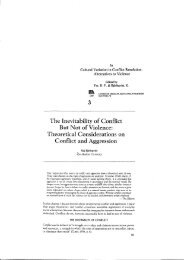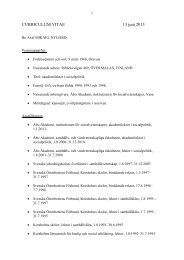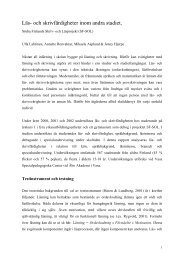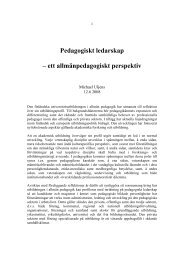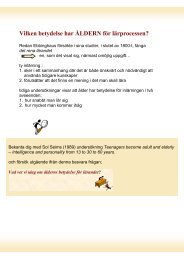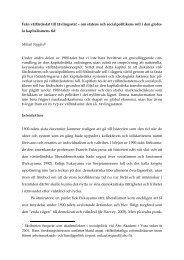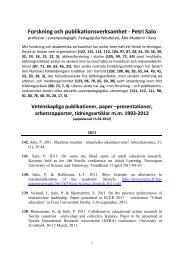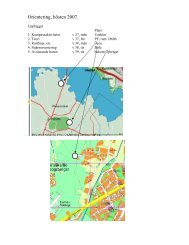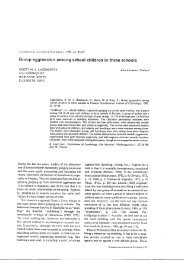Parties, Candidates and Citizens On-Line - Åbo Akademi
Parties, Candidates and Citizens On-Line - Åbo Akademi
Parties, Candidates and Citizens On-Line - Åbo Akademi
Create successful ePaper yourself
Turn your PDF publications into a flip-book with our unique Google optimized e-Paper software.
pursuit of executive office, policy-advocacy <strong>and</strong> pursuit of internal democracy, efficiency<br />
<strong>and</strong> cohesion. Some scholars (Nord 1997; Strömbäck 2002; 2005) have also recently<br />
argued for the inclusion of a fourth arena – the media arena – in this typology. The<br />
argument for this is based on the increasing importance of media in modern politics (cf.<br />
Blumler & Gurevitch 1995; Swanson & Mancini 1996). According to these scholars,<br />
maximization of positive publicity would be a distinctive goal in this arena. However, one<br />
can strongly question this view. Sjöblom (1968, 30) defines party strategies as “the use of<br />
available means with the object of attaining certain goals…”. Positive publicity per se<br />
would therefore appear much likelier to be a means for achieving the goals in the other<br />
arenas, for instance vote maximization, rather than an end goal itself.<br />
A party seeking to maximize its votes places high emphasis on different forms of<br />
propag<strong>and</strong>a <strong>and</strong> campaigning (Sjöblom 1968, 206). Office seeking <strong>and</strong> policy advocating parties<br />
mainly work in the parliamentary arena. The office seeking party seeks to maximize its<br />
control of political office, while the policy advocating party aims at maximizing its<br />
influence in specific areas of public policy (Strom 1990, 567). Tailored st<strong>and</strong>points<br />
constitute the main strategic tools for achieving influence in the parliamentary arena<br />
(Sjöblom 1968, 258). The fourth party goal – internal democracy, efficiency <strong>and</strong> cohesion –<br />
focuses on the participatory aspects of party communication (Römmele 2003, 13). Apart<br />
from general ‘member management’ strategies, bi-directional communication is relatively<br />
highly emphasised (Löfgren 2001, 30; Sjöblom 1968, 195). It is, however, necessary to<br />
realise that most parties pursue all of these goals in different degrees. As noted by Strom<br />
(1990, 570), “Pure vote seekers, office seekers, or policy seekers are unlikely to exist”. The<br />
boundaries of one party may contain several goals – both internal <strong>and</strong> external – which<br />
need to be balanced (Kitchelt 2001, 276).<br />
As mentioned earlier, several scholars (e.g. Gibson et al. 2003a, 67; 2003c; Löfgren<br />
2001; Löfgren & Smith 2003; Römmele 2003) contemplate whether party internet activity<br />
could be linked to their overall goals. According to Römmele (2003, 12), the vote-seeking<br />
party would mostly use the web in the same manner that it uses traditional media to<br />
maximize its votes (cf. Gibson et al. 2003c; Löfgren 2000, 16; 2001, 31-32). Top-down<br />
information <strong>and</strong> broadcasted messages are the main uses of the internet. Interactive<br />
features are seldom used <strong>and</strong> are, as Löfgren points out (2000, 15), usually regarded as a<br />
means for monitoring public opinion rather than for promoting participation (cf. Gibson<br />
et al. 2003c; Römmele 2003, 13). Office-maximizing parties are also expected to mainly use<br />
the web for top-down communication. Some coalition seeking parties could also make<br />
use of targeted information in order to adjust their appearance <strong>and</strong> appear suitable for cooperation<br />
with specific parties (Römmele 2003, 13). Concerning policy seeking parties,<br />
Römmele (2003, 14-15) perceives the internet as mainly being used as a channel for<br />
informing the broad audience of its policy st<strong>and</strong>points <strong>and</strong> also to target specific groups<br />
88



